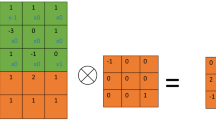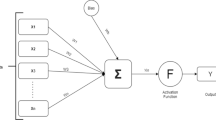Abstract
A neural network model based on a nonlinear dynamic model for solving a class of min-max problems, which is motivated as a non-differentiable optimization problem, is proposed. The main idea is to convert the non-differentiable problem into an equivalent differentiable convex optimization problem using a smoothing scheme called an entropy procedure. A neural network model is then constructed for solving the obtained convex problem. The stability of the equilibrium point and the convergence of the optimal solution are discussed. As an application in economics, we use the proposed scheme to a min-max portfolio optimization problem. Several clarifying examples and simulation results are provided to demonstrate the correctness of the results and the good performance of the presented model.


















































Similar content being viewed by others
References
Agnew D (1981) Improved minimax optimization for circuit design. IEEE Transactions on Circuits and Systems 28:791–803
Chao M, Wang Z, Liang Y, Hu Q (2008) Quadratically constraint quadratical algorithm model for nonlinear minimax problems. Appl Math Comput 205:247–262
Cherkaev E, Cherkaev A (2008) Minimax optimization problem of structural design. Comput Struct 86:1426–1435
Teo KL, Yang XQ (2001) Portfolio selection problem with minimax type risk function. J Ann Oper Res 101:333–349
Di Pillo G, Grippo L, Lucidi S (1997) Smooth transformation of the generalized minimax problem. J Optim Theory Appl 95:1– 24
Cornuejols G, Tutuncu R (2006) Optimization methods in finance. Cambridge University Press, Cambridge
Charalambous C, Conn AR (1978) An efficient method to solve the minimax problem directly. SIAM J Numer Anal 15:162–187
Gigola C, Gomez S (1990) A regularization method for solving the finite convex min-max problem. SIAM J Numer Anal 27:1621–1634
Jian J, Tang C (2005) An SQP feasible desent algorithm for nonlinear inequality constrained optimization without strict complementarity. Comput Math Appl 49:223–238
Jian J, Quan R, Zhang X (2007) Feasible generalized monotone line search SQP algorithm for nonlinear minimax problems with inequality constraints. Comput Appl Math 205:406–429
Polak GG, Rogers DF, Sweeney DJ (2010) Risk management strategies via minimax portfolio optimization. Eur J Oper Res 207:409–419
Li X (1994) An efficient approach to a class of non-smooth optimization problems. Science in China (Series A) 37:323–330
Liang JJ, Suganthan PN, Deb K (2005) Novel composition test functions for numerical global optimization. In: Proceedings 2005 IEEE on swarm intelligence symposium, 2005. SIS 2005. IEEE
Srinivas N, Deb K (1994) Muiltiobjective optimization using nondominated sorting in genetic algorithms. Evol Comput 2.3:221–248
Deb K, Padhye N (2014) Enhancing performance of particle swarm optimization through an algorithmic link with genetic algorithms. Comput Optim Appl 57:761–794
Padhye N, Bhardawaj P, Deb K (2013) Improving differential evolution through a unified approach. J Glob Optim 55:771–799
Li X, Fang S (1997) On the entropy regularization method for solving min-max problems with applications. Math Methods Oper Res 46:119–130
Madsen K, Jacobsen HS (1978) Linear constrained minimax optimization. Math Program 14:208–223
Rustem B, Nguyen Q (1998) An algorithm for the inequality-constrained discrete minimax problem. SIAM J Optim 8:265–283
Shen Z, Huang Z, Wolfe M (1997) An interval maximum entropy method for a discrete minimax problem. Appl Math Comput 87:49–68
Vardi A (1992) New minimax algorithm. J Optim Theory Appl 75:613–634
Xingsia L (1992) An entropy-based aggregate method for minimax optimization. Eng Optim 18:277–285
Xue W, Shen C, Pu D (2009) A new non-monotone SQP algorithm for the minimax problem. Int J Comput Math 86:1149–1159
Ye F, Liu H, Zhou S, Liu S (2008) A smoothing trust-region newton-CG method for minimax problem. Appl Math Comput 199:581–589
Yu YH, Gao L (2002) Nonmonotone linear search algorithm for constrained minimax problem. J Optim Theory Appl 115:419– 446
Zhu Z, Cai X, Jian J (2009) An improved SQP algorithm for solving minimax problems. Appl Math Lett 22:464–469
Tank DW, Hopfield JJ (1986) Simple neural optimization networks: an A/D converter, signal decision circuit, and a linear programming circuit. IEEE Trans Circuits Syst 33:533–541
Chen JS, Ko CH, Pan S (2010) A neural network based on the generalized Fischer–Burmeister function for nonlinear complementarity problems. Inform Sci 180:697–711
Effati S, Nazemi AR (2006) Neural network models and its application for solving linear and quadratic programming problems. Appl Math Comput 172:305–331
Effati S, Ghomashi A, Nazemi AR (2007) Application of projection neural network in solving convex programming problems. Appl Math Comput 188:1103–1114
Gao X (2004) A novel neural network for nonlinear convex programming. IEEE Trans Neural Netw 15:613–621
Gao X, Liao L (2009) A new projection-based neural network for constrained variational inequalities. IEEE Trans Neural Netw 20:373–388
Huang YC (2002) A novel method to handle inequality constraints for convex programming neural network. Neural Process Lett 16:17–27
Malek A, Hosseinipour-Mahani N, Ezazipour S (2009) Efficient recurrent neural network model for the solution of general nonlinear optimization problems. Optim Methods Softw 25:1–18
Nazemi AR (2011) A dynamical model for solving degenerate quadratic minimax problems with constraints. J Comput Appl Math 236:1282–1295
Nazemi AR (2012) A dynamic system model for solving convex nonlinear optimization problems. Commun Nonlinear Sci Numer Simul 17:1696–1705
Nazemi AR (2014) A neural network model for solving convex quadratic programming problems with some applications. Eng Appl Artif Intell 32:54–62
Nazemi AR (2013) Solving general convex nonlinear optimization problems by an efficient neurodynamic model. Eng Appl Artif Intell 26:685–696
Nazemi AR, Omidi F (2012) A capable neural network model for solving the maximum flow problem. J Comput Appl Math 236:3498–3513
Nazemi AR, Omidi F (2013) An efficient dynamic model for solving the shortest path problem. Transp Res C 26:1–19
Nazemi AR, Sharifi E (2013) Solving a class of geometric programming problems by an efficient dynamic model. Commun Nonlinear Sci Numer Simul 18:692–709
Nazemi AR, Effati S (2013) An application of a merit function for solving convex programming problems. Comput Ind Eng 66:212–221
Nazemi AR, Tahmasbi N (2013) A high performance neural network model for solving chance constrained optimization problems. Neurocomputing 121:540–550
Xia Y, Wang J (2004) A recurrent neural network for nonlinear convex optimization subject to nonlinear inequality constraints. IEEE Trans Circuits Syst 51:447–458
Xue X, Bian W (2007) A project neural network for solving degenerate convex quadratic program. Neural Netw 70:2449–2459
Yang Y, Cao J (2010) The optimization technique for solving a class of non-differentiable programming based on neural network method. Nonlinear Anal 11:1108–1114
Rustem B, Nguyen Q (1998) An algorithm for the inequality-constrained discrete min–max problem. SIAM J Optim 8:265– 283
Liu Y, Jian J (2015) New active set identification for general constrained optimization and minimax problems. J Math Anal Appl 421:1405–1416
Yang Y, Cao J, Xu X, Liu J (2012) A generalized neural network for solving a class of minimax optimization problems with linear constraints. Appl Math Comput 218:7528–7537
Bazaraa MS, Sherali HD, Shetty CM (1993) Non-linear programming, theory and algorithms, 2nd edn. Wiley, New York
Hale JK (1969) Ordinary differential equations. Wiley, New York
Facchinei F, Pang J (2003) Finite-dimensional variational inequalities and complementarity problems. Springer, New York
Sastry S (1999) Nonlinear systems analysis. Stability and Control, Springer
Quarteroni A, Sacco R, Saleri F (2007) Numerical mathematics. In: Texts in applied mathematics, 2nd edn., vol 37. Springer, Berlin
Chen J-S, Gao H-T, Pan S-H (2009) An R-linearly convergent derivative-free algorithm for nonlinear complementarity problems based on the generalized Fischer-Burmeister merit function. J Comput Appl Math 232:455–471
Chen J-S, Ko C-H, Pan S-H (2010) A neural network based on the generalized Fischer-Burmeister function for nonlinear complementarity problems. Inf Sci 180:697–711
Chen J-S, Pan S-H (2008) A family of NCP functions and a descent method for the nonlinear comple-mentarity problem. Comput Optim Appl 40:389–404
Sun J, Chen JS, Ko CH (2012) Neural networks for solving second-order cone constrained variational inequality problem. Comput Optim Appl 51:623–648
Yang Y, Cao J (2008) A feedback neural network for solving convex constraint optimization problems. Appl Math Comput 201:340–350
Lillo WE, Loh MH, Hui S, Zăk SH (1993) On solving constrained optimization problems with neural networks: A penalty method approach. IEEE Trans Neural Netw 4:931–939
Kennedy MP, Chua LO (1988) Neural networks for nonlinear programming. IEEE Trans Circuits Syst 35:554–562
Nazemi AR, Effati S (2013) An application of a merit function for solving convex programming problems. Comput Ind Eng 66:212–221
Cai XQ, Teo KL, Yang XQ, Zhou XY (2000) Portfolio optimization under a minimax rule. Manag Sci 46:957–972
Teo KL, Yang XQ (2001) Portfolio selection problem with minimax type risk function. Ann Oper Res 101:333–349
Yu M, Inoue H, Shi J (2006) Portfolio optimization problems with linear programming models. In: Proceedings of the 2006 China international conference in finance
Papahristodoulou C, Dotzauer E (2004) Optimal portfolios using linear programming models. J Oper Res Soc 55:1169–1177
Author information
Authors and Affiliations
Corresponding author
Ethics declarations
Conflict of interests
Disclosure of potential conflicts of interest. The authors declare that they have no conflict of interest.
Informed Consent
Informed consent was obtained from all individual participants included in the study.
Consent for Publication
Chapters don’t contain any studies with human participants performed by any of the authors. Chapters don’t contain any studies with animals performed by any of the authors. Chapters don’t contain any studies with human participants or animals performed by any of the authors.
Rights and permissions
About this article
Cite this article
Nazemi, A., Mortezaee, M. A new gradient-based neural dynamic framework for solving constrained min-max optimization problems with an application in portfolio selection models. Appl Intell 49, 396–419 (2019). https://doi.org/10.1007/s10489-018-1268-1
Published:
Issue Date:
DOI: https://doi.org/10.1007/s10489-018-1268-1




